Karcher HD 7/11-4 Cage, HD 7/16-4 Cage, HD 9/18-4 Cage User guide
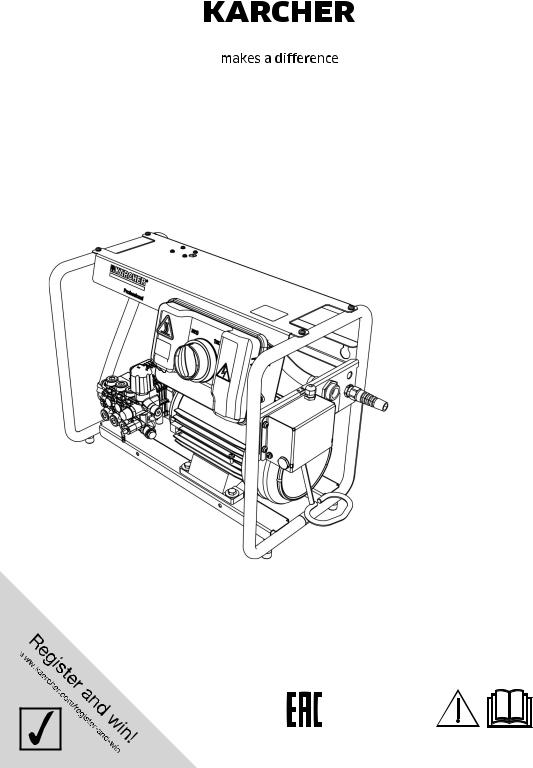
HD 7/11-4 Cage
HD 7/16-4 Cage
HD 9/18-4 Cage
|
|
|
|
|
Deutsch |
5 |
|
|
|
|
|
||
|
|
|
|
|
||
|
|
|
|
|
English |
16 |
|
|
|
|
|
Français |
26 |
|
|
|
|
|
Español |
38 |
|
|
|
|
|
Svenska |
49 |
|
|
|
|
|
Русский |
59 |
|
|
|
|
|
Eesti |
72 |
|
|
|
|
|
Latviešu |
82 |
|
|
|
|
|
Lietuviškai |
93 |
|
|
|
|
|
Українська |
103 |
|
|
|
|
|
Português do |
115 |
|
|
|
|
|
Brasil |
|
|
|
|
|
|
Indonesia |
126 |
|
|
|
|
|
|
137 |
|
|
|
|
|
|
146 |
|
|
|
|
|
|
154 |
|
|
|
|
|
Bahasa Melayu |
162 |
|
|
|
|
|
|
173 |
|
|
|
|
|
ϳΒήόϠ |
191 |
59652900 09/17

2
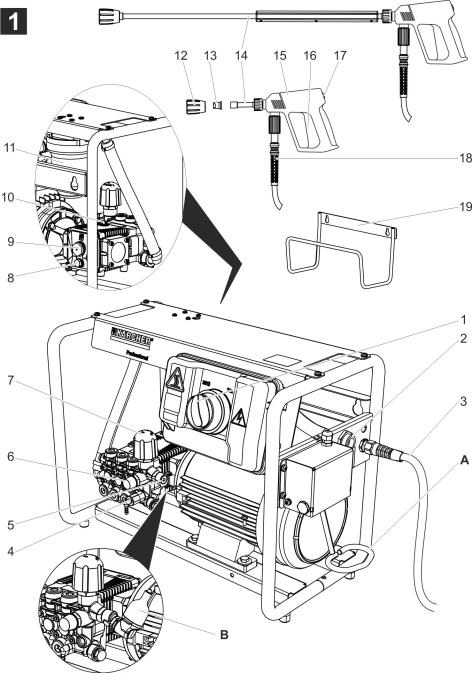
3
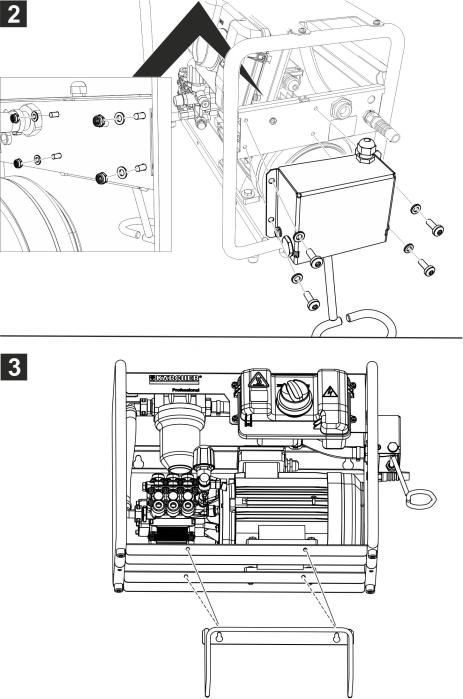
4





 Lesen Sie vor der ersten Benut-
Lesen Sie vor der ersten Benut-  zung Ihres Gerätes diese Originalbetriebsanleitung, handeln Sie danach und bewahren Sie diese für späteren Ge-
zung Ihres Gerätes diese Originalbetriebsanleitung, handeln Sie danach und bewahren Sie diese für späteren Ge-
brauch oder für Nachbesitzer auf.
19 Kabel-/Schlauchablage
* Ausstattung abhängig von Gerätevariante
Sicherheitshinweise
|
|
|
|
|
|
|
– Lesen Sie vor der Inbetriebnahme die |
||||
|
Inhaltsverzeichnis |
|
|||||||||
|
|
|
|
Betriebsanleitung Ihres Gerätes und |
|||||||
|
|
|
|
|
|
|
|
||||
Geräteelemente . . . . . . . . . . . DE |
1 |
|
|
beachten Sie besonders die Sicher- |
|||||||
Sicherheitshinweise . . . . . . . . |
DE |
1 |
|
|
heitshinweise. |
||||||
|
– Die an dem Gerät angebrachten Warn- |
||||||||||
Bestimmungsgemäße Verwen- |
|
|
|
||||||||
|
|
|
|
und Hinweisschilder geben wichtige |
|||||||
dung . . . . . . . . . . . . . . . . . . . . |
DE |
4 |
|
|
|||||||
|
|
Hinweise für den gefahrlosen Betrieb. |
|||||||||
Sicherheitseinrichtungen. . . . . DE |
5 |
|
|
||||||||
|
– Neben den Hinweisen in der Betriebs- |
||||||||||
Umweltschutz . . . . . . . . . . . . . DE |
5 |
|
|||||||||
|
|
anleitung müssen die allgemeinen Si- |
|||||||||
Vor Inbetriebnahme. . . . . . . . . |
DE |
5 |
|
|
|||||||
|
|
cherheitsund Unfallverhütungsvor- |
|||||||||
Inbetriebnahme. . . . . . . . . . . . DE |
6 |
|
|
||||||||
|
|
schriften des Gesetzgebers berück- |
|||||||||
Bedienung. . . . . . . . . . . . . . . . DE |
7 |
|
|
||||||||
|
|
sichtigt werden. |
|||||||||
Transport. . . . . . . . . . . . . . . . . DE |
8 |
|
|
||||||||
|
|
|
|
|
|
||||||
|
Symbole in der Betriebsanleitung |
|
|||||||||
Lagerung. . . . . . . . . . . . . . . . . DE |
8 |
|
|
||||||||
Pflege und Wartung . . . . . . . . DE |
8 |
|
|
GEFAHR |
|||||||
Störungshilfe. . . . . . . . . . . . . . DE |
9 |
|
|||||||||
|
Hinweis auf eine unmittelbar drohende Ge- |
||||||||||
Ersatzteile . . . . . . . . . . . . . . . . DE |
10 |
|
|||||||||
|
fahr, die zu schweren Körperverletzungen |
||||||||||
Garantie . . . . . . . . . . . . . . . . . |
DE |
10 |
|
||||||||
|
oder zum Tod führt. |
||||||||||
EU-Konformitätserklärung. . . . DE |
10 |
|
|||||||||
|
|
WARNUNG |
|||||||||
Technische Daten . . . . . . . . . . |
DE |
11 |
|
||||||||
|
Hinweis auf eine möglicherweise gefährli- |
||||||||||
|
Geräteelemente |
|
|
che Situation, die zu schweren Körperver- |
|||||||
|
|
|
|
|
|
|
letzungen oder zum Tod führen kann. |
||||
Bitte Bildseite vorne ausklappen |
|
||||||||||
|
|
VORSICHT |
|||||||||
Abbildung |
|
|
|
|
|
Hinweis auf eine möglicherweise gefährli- |
|||||
|
|
|
|||||||||
A Halter für Handspritzpistole * |
|
|
che Situation, die zu leichten Verletzungen |
||||||||
B |
Druckschalter * |
|
|
|
führen kann. |
||||||
1 |
Geräteschalter |
|
|
|
ACHTUNG |
||||||
|
|
|
Hinweis auf eine möglicherweise gefährli- |
||||||||
2 |
Wasseranschluss |
|
|
|
che Situation, die zu Sachschäden führen |
||||||
3 |
Netzkabel mit Netzstecker |
|
|
|
kann. |
||||||
4 |
Thermoventil * |
|
|
|
|
|
|
|
|
||
|
|
|
|
|
Symbole auf dem Gerät |
|
|||||
5 |
Sicherheitsventil * |
|
|
|
|
|
|
||||
|
|
|
|
|
|
|
|
||||
6 |
Hochdruckanschluss |
|
|
|
|
|
|
Hochdruckstrahlen können bei |
|||
7 |
Druckund Mengenregulierung |
|
|
|
|
|
unsachgemäßem Gebrauch ge- |
||||
8 |
Ölablassschraube |
|
|
|
|
|
|
fährlich sein. Der Strahl darf |
|||
9 |
Ölstandsanzeige |
|
|
|
nicht auf Personen, Tiere, aktive elektri- |
||||||
10 Öleinfüllschraube |
|
|
|
sche Ausrüstung oder auf das Gerät selbst |
|||||||
11 Wasserfilter |
|
|
|
gerichtet werden. |
|||||||
12 Düsenverschraubung |
|
|
|
|
|
|
Gemäß gültiger Vorschriften darf |
||||
|
|
|
|
|
|
||||||
13 Düse |
|
|
|
|
|
|
das Gerät nie ohne Systemtren- |
||||
14 Strahlrohr |
|
|
|
|
|
|
neramTrinkwassernetzbetrieben |
||||
15 Handspritzpistole |
|
|
|
|
|
|
werden. Es ist ein geeigneter Sys- |
||||
|
|
|
|
|
|
||||||
16 Hebel der Handspritzpistole |
|
|
|
temtrenner der Fa. Kärcher oder alternativ |
|||||||
17 Abzugsicherung |
|
|
|
ein Systemtrenner gemäß EN 12729 Typ |
|||||||
18 Hochdruckschlauch |
|
|
|
BA zu verwenden. |
|||||||
|
|
|
|
|
DE – 1 |
5 |
|||||
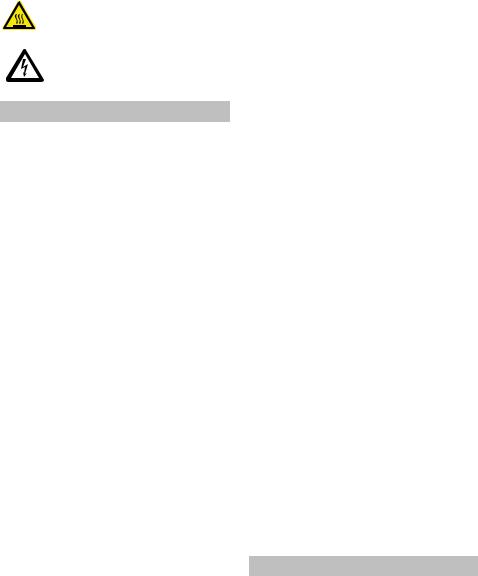
Wasser, das durch einen Systemtrenner geflossen ist, wird als nicht trinkbar eingestuft.
Das Gerät enthält heiße Oberflächen, die zu Verbrennungen führen können.
Gefahr durch elektrischen Schlag. Gehäuse darf nur durch elektrisches Fachpersonal geöffnet werden.
Stromanschluss
–Die angegebene Spannung auf dem Typenschild muss mit der Spannung der Stromquelle übereinstimmen.
–Mindestabsicherung der Steckdose (siehe Technische Daten).
–Schutzklasse I - Geräte dürfen nur an ordnungsgemäß geerdete Stromquellen angeschlossen werden.
–Es wird empfohlen, dieses Gerät nur an eine Steckdose anzuschließen, die mit einem 30 mA Fehlerstrom-Schutz- schalter abgesichert ist.
–Die vom Hersteller vorgeschriebene Netzanschlussleitung ist zu verwenden, dies gilt auch bei Ersatz der Leitung. Bestell-Nr. und Type siehe Betriebsanleitung.
–Anschlussleitung mit Netzstecker vor jedem Betrieb auf Schäden prüfen. Beschädigte Anschlussleitung unverzüglich durch autorisierten Kundendienst/ Elektro-Fachkraft austauschen lassen.
–Das Gerät darf nur an einen elektrischen Anschluss angeschlossen werden, der von einem Elektroinstallateur gemäß IEC 60364-1 ausgeführt wurde.
–Einschaltvorgänge erzeugen kurzzeitige Spannungsabsenkungen.
–Bei ungünstigen Netzbedingungen können Beeinträchtigungen anderer Geräte auftreten.
–Den Netzstecker niemals mit nassen Händen anfassen.
–Es ist darauf zu achten, dass die Netzanschlussleitung oder das Verlängerungskabel nicht durch Überfahren, Quetschen, Zerren oder dergleichen
verletzt oder beschädigt werden. Schützen Sie das Kabel vor Hitze, Öl und scharfen Kanten.
–Das Verlängerungskabel muss den in der Betriebsanleitung aufgeführten Querschnitt haben und spritzwassergeschützt sein. Die Verbindung darf nicht im Wasser liegen.
–Netzstecker und Kupplung einer Verlängerungsleitung müssen wasserdicht sein und dürfen nicht im Wasser liegen. Die Kupplung darf weiterhin nicht auf dem Boden liegen. Es wird empfohlen, Kabeltrommeln zu verwenden, die gewährleisten, dass die Steckdosen sich mindestens 60 mm über dem Boden befinden.
–Ungeeignete elektrische Verlängerungsleitungen können gefährlich sein. Verwenden Sie im Freien nur dafür zugelassene und entsprechend gekennzeichnete elektrische Verlängerungsleitungen mit ausreichendem Leitungsquerschnitt.
–Die Netzanschlussleitung ist regelmäßig auf Beschädigung zu untersuchen, wie z.B. auf Rissbildung oder Alterung. Falls eine Beschädigung festgestellt wird, muss die Leitung vor weiterem Gebrauch ersetzt werden.
–Beim Ersetzen von Kupplungen an Netzanschlussoder Verlängerungsleitung müssen der Spritzwasserschutz und die mechanische Festigkeit gewährleistet bleiben.
–Die Reinigung des Gerätes darf nicht mit Schlauchoder Hochdruckwasserstrahl erfolgen (Gefahr von Kurzschlüssen oder anderer Schäden).
–Das Gerät bei Temperaturen unter 0 °C nicht betreiben.
Wasseranschluss
–Beachten Sie die Vorschriften Ihres Wasserversorgungsunternehmens.
–Die Verschraubung aller Anschlussschläuche muss dicht sein.
–Der Hochdruckschlauch darf nicht beschädigt sein. Ein beschädigter Hoch-
6 |
DE – 2 |

druckschlauch muss unverzüglich ausgetauscht werden. Es dürfen nur vom Hersteller empfohlene Schläuche und Verbindungen verwendet werden. Be- stell-Nr. siehe Betriebsanleitung.
Anwendung
–Das Gerät mit den Arbeitseinrichtungen ist vor Benutzung auf den ordnungsgemäßen Zustand und die Betriebssicherheit zu prüfen.
Das Gerät nicht benutzen, wenn eine Anschlussleitung oder wichtige Teile des Gerätes beschädigt sind, z. B. Sicherheitseinrichtungen, Hochdruckschläuche, Handspritzpistolen.
–Niemals lösungsmittelhaltige Flüssigkeiten oder unverdünnte Säuren und Lösungsmittel ansaugen! Dazu zählen z.B. Benzin, Farbverdünner oder Heizöl. Der Sprühnebel ist hochentzündlich, explosiv und giftig. Kein Aceton, unverdünnte Säuren und Lösungsmittel verwenden, da sie die am Gerät verwendeten Materialien angreifen.
–Beim Einsatz des Gerätes in Gefahrbereichen (z. B. Tankstellen) sind die entsprechenden Sicherheitsvorschriften zu beachten. Der Betrieb in explosionsgefährdeten Räumen ist untersagt.
–Das Gerät muss einen ebenen, standfesten Untergrund haben.
–Ist in der Betriebsanleitung des Gerätes (Technische Daten) ein Schalldruckpegel über 80 dB(A) angegeben, Gehörschutz tragen.
–Alle stromführenden Teile im Arbeitsbereich müssen strahlwassergeschützt sein.
–Der Hebel der Handspritzpistole darf bei Betrieb nicht festgeklemmt werden.
–Zum Schutz vor zurückspritzendem Wasser oder Schmutz geeignete Schutzkleidung und Schutzbrille tragen.
–Hochdruckstrahlen können bei unsachgemäßem Gebrauch gefährlich sein. Der Strahl darf nicht auf Personen, Tiere, aktive elektrische Ausrüstung oder auf das Gerät selbst gerichtet werden.
–Den Strahl nicht auf andere oder sich selbst richten, um Kleidung oder Schuhwerk zu reinigen.
–Fahrzeugreifen/Reifenventile dürfen nur mit einem Mindest-Spritzabstand von 30 cm gereinigt werden. Sonst kann der Fahrzeugreifen/das Reifenventil durch den Hochdruckstrahl beschädigt werden. Das erste Anzeichen einer Beschädigung ist die Verfärbung des Reifens. Beschädigte Fahrzeugreifen sind eine Gefahrenquelle.
–Asbesthaltige und andere Materialien, die gesundheitsgefährdende Stoffe enthalten, dürfen nicht abgespritzt werden.
–Bei kurzen Strahlrohren besteht Verletzungsgefahr, da eine Hand versehentlich mit dem Hochdruckstrahl in Berührung kommen kann. Ist das verwendete Strahlrohr kürzer als 75 cm, darf keine Punktstrahldüse oder Rotordüse verwendet werden.
–Vor der Reinigung muss eine Risikobeurteilung der zu reinigenden Oberfläche vorgenommen werden, um Sicherheitsund Gesundheitsschutzanforderungen zu ermitteln. Es sind entsprechend notwendige Schutzmaßnahmen zu ergreifen.
–Schläuche nach dem Heißwasserbetrieb abkühlen lassen oder Gerät kurz im Kaltwasserbetrieb betreiben.
–Bei längeren Betriebspausen Gerät am Hauptschalter / Geräteschalter ausschalten oder Netzstecker ziehen.
Bedienung
–Die Bedienperson hat das Gerät bestimmungsgemäß zu verwenden. Sie hat die örtlichen Gegebenheiten zu berücksichtigen und beim Arbeiten mit dem Gerät auf Dritte, insbesondere Kinder, zu achten.
–Das Gerät darf niemals unbeaufsichtigt gelassen werden, solange es in Betrieb ist.
–Das Gerät darf nur von Personen benutzt werden, die in der Handhabung unterwiesen sind oder die ihre Fähig-
DE – 3 |
7 |

keiten zum Bedienen nachgewiesen haben und ausdrücklich mit der Benutzung beauftragt sind. Das Gerät darf nicht von Kindern oder Jugendlichen betrieben werden.
–Dieses Gerät ist nicht dafür bestimmt, durch Personen mit eingeschränkten physischen, sensorischen oder geistigen Fähigkeiten benutzt zu werden.
–Das Gerät darf nicht von Kindern oder nicht unterwiesenen Personen betrieben werden.
–Das Gerät nicht verwenden, wenn sich andere Personen in Reichweite befinden, es sei denn, sie tragen Schutzkleidung.
–Kinder sollten beaufsichtigt werden, um sicherzustellen, dass sie nicht mit dem Gerät spielen.
–Arbeiten am Gerät immer mit geeigneten Handschuhen durchführen.
–Durch den aus dem Strahlrohr austretenden Wasserstrahl entsteht eine Rückstoßkraft. Durch das abgewinkelte Strahlrohr wirkt eine Kraft nach oben. Pistole und Strahlrohr gut festhalten.
–Bei Verwendung von abgewinkelten Spritzeinrichtungen können sich die Rückstoßund Verdrehkräfte verändern.
Transport
Beim Transport des Gerätes ist der Motor stillzusetzen und das Gerät sicher zu befestigen.
Wartung
–Vor dem Reinigen und Warten des Gerätes und dem Auswechseln von Teilen ist das Gerät auszuschalten und bei netzbetriebenen Geräten der Netzstecker zu ziehen.
–Vor allen Arbeiten an Gerät und Zubehör Hochdrucksystem drucklos machen.
–Instandsetzungen dürfen nur durch zugelassene Kundendienststellen oder durch Fachkräfte für dieses Gebiet, welche mit allen relevanten Sicherheitsvorschriften vertraut sind, durchgeführt werden.
–Ortsveränderliche gewerblich genutzte Geräte unterliegen der Sicherheitsüberprüfung nach den örtlich geltenden Vorschriften (z.B. in Deutschland: VDE 0701).
Zubehör und Ersatzteile
–Um Gefährdungen zu vermeiden, dürfen Reparaturen und der Einbau von Ersatzteilen nur vom autorisierten Kundendienst durchgeführt werden.
–Es dürfen nur Zubehör und Ersatzteile verwendet werden, die vom Hersteller freigegeben sind. Original-Zubehör und Original-Ersatzteile bieten die Gewähr dafür, dass das Gerät sicher und störungsfrei betrieben werden kann.
Bestimmungsgemäße
Verwendung
Diesen Hochdruckreiniger ausschließlich verwenden
–zum Reinigen mit Hochdruckstrahl ohne Reinigungsmittel (z.B. Reinigen von Fassaden, Terrassen, Gartengerä-
ten, Fahrzeugen und ähnlichen Gegenständen).
Für hartnäckige Verschmutzungen empfehlen wir den Dreckfräser als Sonderzubehör.
Anforderungen an die Wasserqualität:
ACHTUNG
Als Hochdruckmedium darf nur sauberes Wasser verwendet werden. Verschmutzungen führen zu vorzeitigem Verschleiß oder Ablagerungen im Gerät.
Wird Recyclingwasser verwendet, dürfen folgende Grenzwerte nicht überschritten werden.
pH-Wert |
6,5...9,5 |
elektrische Leitfähigkeit * |
Leitfähigkeit |
|
Frischwasser |
|
+1200 µS/cm |
absetzbare Stoffe ** |
< 0,5 mg/l |
abfiltrierbare Stoffe *** |
< 50 mg/l |
Kohlenwasserstoffe |
< 20 mg/l |
Chlorid |
< 300 mg/l |
8 |
DE – 4 |
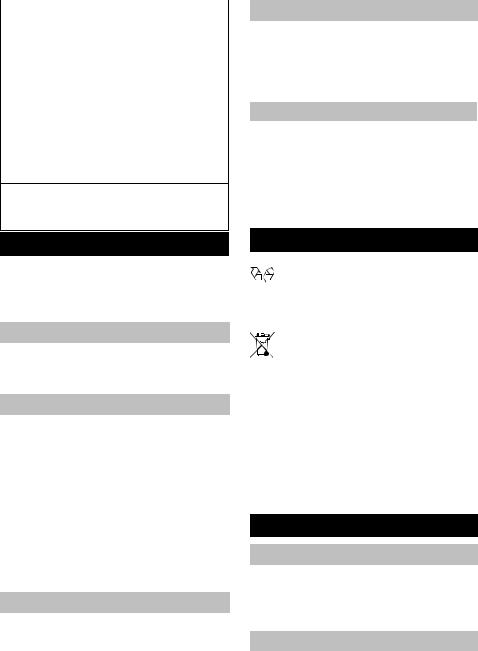
Sulfat |
< 240 mg/l |
Kalzium |
< 200 mg/l |
Gesamthärte |
< 28 °dH |
|
< 50 °TH |
|
< 500 ppm |
|
(mg CaCO3/l) |
Eisen |
< 0,5 mg/l |
Mangan |
< 0,05 mg/l |
Kupfer |
< 2 mg/l |
Aktivchlor |
< 0,3 mg/l |
frei von üblen Gerüchen |
|
* Maximum insgesamt 2000 µS/cm
**Probevolumen 1 l, Absetzzeit 30 min
***keine abrasiven Stoffe
Sicherheitseinrichtungen
Sicherheitseinrichtungen dienen dem Schutz des Benutzers und dürfen nicht außer Betrieb gesetzt oder in ihrer Funktion umgangen werden.
Abzugsicherung
Die Abzugsicherung an der Handspritzpistole verhindert unbeabsichtigtes Einschalten des Gerätes.
Überströmventil
–Beim Reduzieren der Wassermenge mit der Druck-/Mengenregulierung öffnet das Überströmventil und ein Teil des Wassers fließt zur Pumpensaugseite zurück.
–Wird die Handspritzpistole geschlossen, öffnet das Überströmventil und die komplette Wassermenge fließt zur Pumpensaugseite zurück.
Das Überströmventil ist werkseitig eingestellt und plombiert. Einstellung nur durch den Kundendienst.
Sicherheitsventil
Das Sicherheitsventil öffnet, wenn das Überströmventil defekt ist.
Das Sicherheitsventil ist werkseitig eingestellt und plombiert. Einstellung nur durch den Kundendienst.
Nicht alle Gerätevarianten sind mit einem Sicherheitsventil ausgestattet.
Thermoventil
Das Thermoventil schützt die Hochdruckpumpe gegen unzulässige Erwärmung im Kreislaufbetrieb.
Nicht alle Gerätevarianten sind mit einem Thermoventil ausgestattet.
Druckschalter
Wird der Hebel an der Handspritzpistole losgelassen, schaltet der Druckschalter die Pumpe ab, der Hochdruckstrahl stoppt. Wird der Hebel gezogen, schaltet die Pumpe wieder ein.
Nicht alle Gerätevarianten sind mit einem Druckschalter ausgestattet.
Umweltschutz
 Die Verpackungsmaterialien sind re-
Die Verpackungsmaterialien sind re-
cyclebar. Bitte werfen Sie die Verpackungen nicht in den Hausmüll, sondern führen Sie diese einer Wiederverwertung zu.
Altgeräte enthalten wertvolle recyclingfähige Materialien, die einer Ver-
 wertung zugeführt werden sollten. Batterien und Akkus enthalten Stoffe, die nicht in die Umwelt gelangen dürfen. Bitte entsorgen Sie Altgeräte, Batterien und Akkus deshalb über geeignete Sammelsysteme.
wertung zugeführt werden sollten. Batterien und Akkus enthalten Stoffe, die nicht in die Umwelt gelangen dürfen. Bitte entsorgen Sie Altgeräte, Batterien und Akkus deshalb über geeignete Sammelsysteme.
Hinweise zu Inhaltsstoffen (REACH)
Aktuelle Informationen zu Inhaltsstoffen finden Sie unter: www.kaercher.de/REACH
Vor Inbetriebnahme
Auspacken
–Packungsinhalt beim Auspacken prüfen.
–Bei Transportschaden sofort Händler informieren.
Ölstand kontrollieren
Der Ölspiegel muss in der Mitte der Ölstandsanzeige sein.
DE – 5 |
9 |
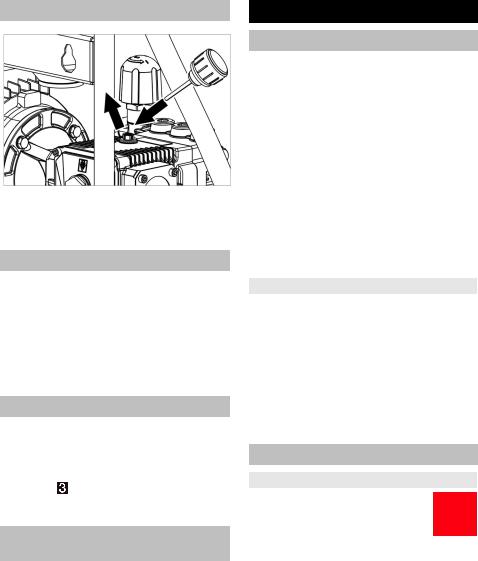
Entlüftung Ölbehälter aktivieren
Verschlussschraube herausdrehen.
Beiliegende Öleinfüllschraube einschrauben.
Gerätehaube schließen.
Zubehör montieren
Strahlrohr mit der Handspritzpistole verbinden.
Düse mit Düsenverschraubung am Strahlrohr montieren.
Hochdruckschlauch an der Handspritzpistole festschrauben.
Hochdruckschlauch am Hochdruckanschluss festschrauben.
Kabel-/ Schlauchablage montieren
Bei Bedarf beiliegende Kabel-/ Schlauchablage an der Wand anbrin-
gen. oder
Abbildung
Beiliegende Kabel-/Schlauchablage an der Unterseite des Gerätes anbringen.
Halter für Handspritzpistole befestigen
Hinweis:
Nicht alle Gerätevarianten sind mit dem Halter für die Handspritzpistole ausgestattet.
Abbildung 
Halter befestigen.
Inbetriebnahme
Elektrischer Anschluss
GEFAHR
Verletzungsgefahr durch elektrischen Schlag.
Gerät nur an Wechselstrom anschließen. Das Gerät muss zwingend mit einem Stecker an das elektrische Netz angeschlossen werden. Eine nicht trennbare Verbindung mit dem Stromnetz ist verboten. Der Stecker dient zur Netztrennung.
Verlängerungskabel mit ausreichendem Querschnitt verwenden (siehe „Technische Daten“) und ganz von der Kabeltrommel abwickeln.
Anschlusswerte siehe Typenschild/Technische Daten.
HD 7/11-4 Cage:
WARNUNG
Die maximal zulässige Netzimpedanz am elektrischen Anschlusspunkt (siehe Technische Daten) darf nicht überschritten werden.
Bei Unklarheiten bezüglich der an Ihrem Anschlusspunkt vorliegenden Netzimpedanz setzen Sie sich bitte mit Ihrem Energieversorgungsunternehmen in Verbindung.
Wasseranschluss
Anschluss an die Wasserleitung
Gemäß gültigen Vorschriften darf das Gerät nie ohne Systemtrenner
am Trinkwassernetz betrieben werden. Stellen Sie sicher, dass
der Anschluss Ihrer Hauswasseranlage, an dem der Hochdruckreiniger betrieben wird, mit einem Systemtrenner gemäß EN 12729 Typ BA ausgestattet ist.
Wasser, das durch einen Systemtrenner geflossen ist, wird als nicht trinkbar eingestuft.
VORSICHT
Systemtrenner immer an der Wasserversorgung, niemals direkt am Gerät anschließen.
10 |
DE – 6 |

Anschlusswerte siehe Technische Daten.
Zulaufschlauch (Mindestlänge 7,5 m, Mindestdurchmesser 3/4“) am Wasseranschluss des Gerätes und am Wasserzulauf (zum Beispiel Wasserhahn)
anschließen.
Hinweis:
Der Zulaufschlauch ist nicht im Lieferumfang enthalten.
Wasserzulauf öffnen.
Wasser aus offenen Behältern ansaugen
Saugschlauch am Wasseranschluss anschrauben.
Hinweis:
Der Saugschlauch ist nicht im Lieferumfang enthalten.
Wird ein Saugschlauch mit Rückschlagventil oder Filter verwendet, muss der Schlauch mit Wasser gefüllt sein.
Gerät entlüften: Düse abschrauben.
Gerät so lange laufen lassen bis das Wasser blasenfrei austritt. Eventuell Gerät 10 Sekunden laufen
lassen – ausschalten. Vorgang mehrmals wiederholen.
Gerät ausschalten und Düse wieder aufschrauben.
Bedienung
GEFAHR
Explosionsgefahr!
Keine brennbaren Flüssigkeiten versprühen.
Beim Einsatz des Gerätes in Gefahrbereichen (z.B. Tankstellen) sind die entsprechenden Sicherheitsvorschriften zu beachten.
ACHTUNG
Motoren nur an Stellen mit entsprechendem Ölabscheider reinigen (Umweltschutz).
GEFAHR
Längere Benutzungsdauer des Gerätes kann zu vibrationsbedingten Durchblutungsstörungen in den Händen führen.
Eine allgemein gültige Dauer für die Benutzung kann nicht festgelegt werden, weil diese von mehreren Einflussfaktoren abhängt:
–Persönliche Veranlagung zu schlechter Durchblutung (häufig kalte Finger, Fingerkribbeln).
–Niedrige Umgebungstemperatur. Warme Handschuhe zum Schutz der Hände tragen.
–Festes Zugreifen behindert die Durchblutung.
–Ununterbrochener Betrieb ist schlechter als durch Pausen unterbrochener
Betrieb.
Bei regelmäßiger, langandauernder Benutzung des Gerätes und bei wiederholtem Auftreten entsprechender Anzeichen (zum Beispiel Fingerkribbeln, kalte Finger) empfehlen wir eine ärztliche Untersuchung.
Betrieb mit Hochdruck
Gerät mit |
Geräteschalter auf „I“ stel- |
Halter für |
len. |
Handspritz Handspritzpistole vom |
|
pistole (A) |
Halter abnehmen, das Ge- |
|
rät schaltet ein. |
Gerät mit |
Geräteschalter auf „I“ stel- |
Druck- |
len. |
schalter |
Das Gerät ist betriebsbe- |
(B)reit und startet, wenn der Hebel der Handspritzpistole betätigt wird.
Gerätohne Geräteschalter auf „I“ stel-
(A) und (B) |
len. |
|
Das Gerät schaltet ein. |
Abzugsicherung entriegeln und Hebel der Handspritzpistole ziehen.
Arbeitsdruck und Wassermenge durch Drehen (stufenlos) an der Druckund Mengenregulierung einstellen(+/-)
Betrieb unterbrechen
Kurzzeitige Unterbrechung
Hebel der Handspritzpistole loslassen. Gerät mit Druckschalter (B) schaltet aus.
DE – 7 |
11 |
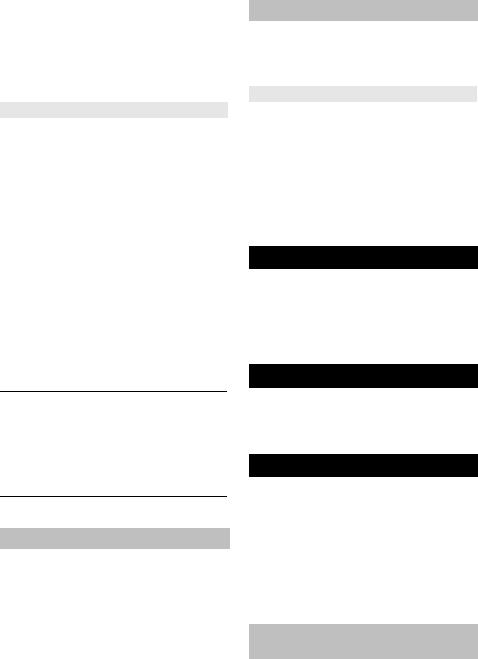
Geräte ohne Druckschalter gehen in Kreislaufbetrieb.
Hebel der Handspritzpistole erneut ziehen.
Gerät mit Druckschalter startet. Geräte ohne Druckschalter beenden den Kreislaufbetrieb.
Längere Unterbrechung
Hebel der Handspritzpistole loslassen.
Abzugsicherung der Handspritzpistole betätigen, um Hebel der Pistole gegen unabsichtliches Auslösen zu sichern.
Gerät mit |
Handspritzpistole am Hal- |
Halter für |
ter einhängen. |
Handspritz |
Die Pumpe stoppt. |
pistole (A) |
Handspritzpistole vom |
|
Halter abnehmen. |
|
Die Pumpe startet. |
Gerät mit |
Geräteschalter auf „0/ |
Druck- |
OFF“ stellen. |
schalter |
Die Pumpe ist ausge- |
(B)schaltet.
Geräteschalter auf „I“ stellen.
Die Pumpe ist betriebsbereit.
Gerätohne Geräteschalter auf „0/
(A) und (B) OFF“ stellen.
Die Pumpe ist ausgeschaltet.
Geräteschalter auf „I“ stellen.
Die Pumpe startet.
Abzugsicherung entriegeln und Hebel der Handspritzpistole ziehen.
Gerät ausschalten
Geräteschalter auf „0“ stellen.
Netzstecker aus der Steckdose ziehen.
Wasserzulauf schließen.
Handspritzpistole betätigen, bis das Gerät drucklos ist.
Abzugsicherung der Handspritzpistole betätigen, um Hebel der Pistole gegen unabsichtliches Auslösen zu sichern.
Frostschutz
ACHTUNG
Frost zerstört das nicht vollständig von Wasser entleerte Gerät.
Gerät an einem frostfreien Ort aufbewahren.
Ist eine frostfreie Lagerung nicht möglich:
Wasser ablassen.
Handelsübliches Frostschutzmittel durch das Gerät pumpen.
Hinweis:
Handelsübliches Frostschutzmittel für Automobile auf Glykolbasis verwenden. Handhabungsvorschriften des Frostschutzmittelherstellers beachten.
Gerät max. 1 Minute laufen lassen bis Pumpe und Leitungen leer sind.
Transport
Beim Transport in Fahrzeugen Gerät nach den jeweils gültigen Richtlinien gegen Rutschen und Kippen sichern.
VORSICHT
Verletzungsund Beschädigungsgefahr! Gewicht des Gerätes beim Transport beachten.
Lagerung
VORSICHT
Verletzungsund Beschädigungsgefahr! Gewicht des Gerätes bei Lagerung beachten.
Pflege und Wartung
GEFAHR
Verletzungsgefahr durch unabsichtlich anlaufendes Gerät und elektrischen Schlag. Vor allen Arbeiten am Gerät, Gerät ausschalten und Netzstecker ziehen.
Hinweis:
Altöl darf nur von den dafür vorgesehenen Sammelstellen entsorgt werden. Bitte geben Sie anfallendes Altöl dort ab. Verschmutzen der Umwelt mit Altöl ist strafbar.
Sicherheitsinspektion/
Wartungsvertrag
Mit Ihrem Händler können Sie eine regelmäßige Sicherheitsinspektion vereinbaren oder einen Wartungsvertrag abschließen. Bitte lassen Sie sich beraten.
12 |
DE – 8 |

Vor jedem Betrieb
Anschlusskabel auf Schaden prüfen (Gefahr durch elektrischen Schlag), beschädigtes Anschlusskabel unverzüglich durch autorisierten Kundendienst/ Elektrofachkraft austauschen lassen.
Hochdruckschlauch auf Beschädigung überprüfen (Berstgefahr). Beschädigten Hochdruckschlauch unverzüglich austauschen.
Gerät (Pumpe) auf Dichtheit prüfen. 3 Tropfen Wasser pro Minute sind zulässig und können an der Geräteunterseite austreten. Bei stärkerer
Undichtigkeit Kundendienst aufsuchen.
Wöchentlich
Ölstand prüfen. Bei milchigem Öl (Wasser im Öl) sofort Kundendienst aufsuchen.
Wasserfilter reinigen.
Jährlich oder nach 500
Betriebsstunden
Öl wechseln.
Ölwechsel
Hinweis:
Ölmenge und -sorte siehe „Technische Daten“.
Ölablassschraube herausschrauben.
Öl in Auffangbehälter ablassen.
Ölablassschraube eindrehen und festziehen.
Drehmoment 20...25 Nm.
Öleinfüllschraube herausdrehen.
Neues Öl langsam einfüllen; Luftblasen müssen entweichen.
Der Ölspiegel muss in der Mitte der Ölstandsanzeige sein.
Öleinfüllschraube einschrauben.
Gerätehaube schließen.
Störungshilfe
GEFAHR
Verletzungsgefahr durch unabsichtlich anlaufendes Gerät und elektrischen Schlag. Vor allen Arbeiten am Gerät, Gerät ausschalten und Netzstecker ziehen.
Elektrische Bauteile nur vom autorisierten Kundendienst prüfen und reparieren lassen.
Bei Störungen, die in diesem Kapitel nicht genannt sind, im Zweifelsfall und bei ausdrücklichem Hinweis einen autorisierten Kundendienst aufsuchen.
Gerät läuft nicht
Nur bei Geräten mit Halter für Handspritzpistole: Halter nicht herunterdrücken.
Anschlusskabel auf Schaden prüfen.
Netzspannung prüfen.
Bei elektrischem Defekt Kundendienst aufsuchen.
Gerät kommt nicht auf Druck
Druckund Mengenregulierung auf „MAX“ stellen.
Düsengröße prüfen, richtige Düse montieren.
Düse reinigen.
Düse ersetzen.
Gerät entlüften (siehe „Inbetriebnahme“).
Wasserzulaufmenge prüfen (siehe Technische Daten).
Wasserfilter reinigen.
Sämtliche Zulaufleitungen zur Pumpe prüfen.
Bei Bedarf Kundendienst aufsuchen.
Pumpe undicht
3 Tropfen Wasser pro Minute sind zulässig und können an der Geräteunterseite austreten. Bei stärkerer Undichtigkeit Kundendienst aufsuchen.
Bei stärkerer Undichtigkeit Gerät durch Kundendienst prüfen lassen.
Pumpe klopft
Wasserfilter reinigen.
Saugleitungen für Wasser auf Undichtheit prüfen.
Gerät entlüften (siehe „Inbetriebnahme“).
Bei Bedarf Kundendienst aufsuchen.
DE – 9 |
13 |

Wasseraustritt am Thermoventil
Diese Funktion ist keine Störung. Wird das Gerät im Kreislaufbetrieb zu heiß, öffnet das Thermoventil, damit kaltes Wasser nachströmen kann.
Wasseraustritt am Sicherheitsventil
Gerät ausschalten, kurz warten, Gerät wieder einschalten.
Tritt die Störung danach wieder auf, Gerätnichtmehrbenützen.Gerätdurch Kundendienst prüfen lassen.
Ersatzteile
–Es dürfen nur Zubehör und Ersatzteile verwendet werden, die vom Hersteller freigegeben sind. Original-Zubehörund Original-Ersatzteile bieten die Gewähr dafür, dass das Gerät sicher und störungsfrei betrieben werden kann.
–Eine Auswahl der am häufigsten benötigten Ersatzteile finden Sie am Ende der Betriebsanleitung.
–Weitere Informationen über Ersatzteile erhalten Sie unter www.kaercher.com im Bereich Service.
Garantie
In jedem Land gelten die von unserer zuständigen Vertriebsgesellschaft herausgegebenen Garantiebedingungen. Etwaige Störungen an Ihrem Gerät beseitigen wir innerhalb der Garantiefrist kostenlos, sofern ein Materialoder Herstellungsfehler die Ursache sein sollte. Im Garantiefall wenden Sie sich bitte mit Kaufbeleg an Ihren Händler oder die nächste autorisierte Kundendienststelle.
EU-Konformitätserklärung
Hiermit erklären wir, dass die nachfolgend bezeichnete Maschine aufgrund ihrer Konzipierung und Bauart sowie in der von uns in Verkehr gebrachten Ausführung den einschlägigen grundlegenden Sicherheitsund Gesundheitsanforderungen der EURichtlinien entspricht. Bei einer nicht mit unsabgestimmten Änderung derMaschine verliert diese Erklärung ihre Gültigkeit.
Produkt: Hochdruckreiniger
Typ: 1.367-xxx
Einschlägige EU-Richtlinien
2006/42/EG (+2009/127/EG) 2014/30/EU
2000/14/EG
2011/65/EU
Angewandte harmonisierte Normen
EN 60335–1
EN 60335–2–79
EN 55014–1: 2006+A1: 2009+A2: 2011 EN 55014–2: 2015
EN 62233: 2008 EN 61000–3–2: 2014
EN 61000–3–11: 2000 EN 50581
Angewandtes Konformitätsbewer-
tungsverfahren
2000/14/EG: Anhang V
Schallleistungspegel dB(A)
HD 7/11-4
Gemessen: 87
Garantiert: 90
HD 7/16-4
Gemessen: 87
Garantiert: 90
HD 9/18-4
Gemessen: 84
Garantiert: 87
Die Unterzeichnenden handeln im Auftrag und mit Vollmacht der Geschäftsführung.
Chief Executive Officer Head of Approbation
Dokumentationsbevollmächtigter:
S. Reiser
Alfred Kärcher GmbH & Co. KG
Alfred-Kärcher-Str. 28 - 40
71364 Winnenden (Germany)
Tel.: +49 7195 14-0
Fax: +49 7195 14-2212
Winnenden, 2015/08/01
14 |
DE – 10 |

Technische Daten
Typ |
|
HD 7/11-4 |
HD 7/16-4HD 9/18-4 |
HD 9/18-4 |
|||
Netzanschluss |
|
|
|
|
|
|
|
Spannung |
V |
220...240 |
380...415 |
|
380...480 |
||
Stromart |
Hz |
1~50 |
3~50 |
|
|
3~60 |
|
Anschlussleistung |
kW |
2,9 |
4,3 |
|
5,9 |
|
6,9 |
Absicherung (träge, Char. C) |
A |
13 |
|
|
16 |
|
|
Maximal zulässige Netzimpedanz |
Ohm |
0,365 |
|
|
-- |
|
|
Schutzart |
-- |
|
IPX5 |
|
|
|
|
Verlängerungskabel 30 m |
mm2 |
|
2,5 |
|
|
|
|
Wasseranschluss |
|
|
|
|
|
|
|
Zulauftemperatur (max.) |
°C |
|
60 |
|
|
|
|
Zulaufmenge (min.) |
l/h (l/min) |
1000 (16,67) |
|
1200 (20) |
|||
Saughöhe aus offenem Behälter (20 °C) |
m |
|
0,5 |
|
|
|
|
Zulaufdruck (max.) |
MPa (bar) |
|
1,0 (10) |
|
|
||
Leistungsdaten |
|
|
|
|
|
|
|
Arbeitsdruck |
MPa (bar) |
7...11 |
7...16 |
|
7...18 (70...180) |
||
|
|
(70...110) |
(70...160) |
|
|
|
|
Max. Betriebsüberdruck |
MPa (bar) |
15 (150) |
|
25 (250) |
|
||
Düsengröße |
-- |
050 |
040 |
|
050 |
|
055 |
Fördermenge |
l/h (l/min) |
520...700 |
400...700 |
450...900 |
(7,5...15) |
||
|
|
(8,7...11,7 |
(6,7...11,7 |
|
|
|
|
|
|
) |
) |
|
|
|
|
Rückstoßkraft der Handspritzpistole |
N |
29 |
35 |
|
48 |
|
53 |
(max.) |
|
|
|
|
|
|
|
Ermittelte Werte gemäß EN 60335- |
2-79 |
|
|
|
|
|
|
Hand-Arm Vibrationswert |
m/s2 |
|
<2,5 |
|
|
|
2,7 |
Unsicherheit K |
m/s2 |
|
0,6 |
|
|
|
0,8 |
Schalldruckpegel LpA |
dB(A) |
74 |
87 |
|
84 |
|
78 |
Unsicherheit KpA |
dB(A) |
|
3 |
|
|
|
|
Schallleistungspegel LWA + Unsi- |
dB(A) |
90 |
90 |
|
87 |
|
93 |
cherheit KWA |
|
|
|
|
|
|
|
Betriebsstoffe |
|
|
|
|
|
|
|
Ölmenge |
l |
|
0,4 |
|
|
|
|
Ölsorte |
-- |
|
15W40 |
|
|
||
Maße und Gewichte |
|
|
|
|
|
|
|
Länge |
mm |
640 |
780 |
|
|
640 |
|
Breite |
mm |
|
360 |
|
|
|
|
Höhe |
mm |
|
500 |
|
|
|
|
Gewicht, betriebsbereit mit Zubehör |
kg |
50,5 |
56,5 |
|
55,2 |
|
61,2 |
DE – 11 |
15 |





 Pleasereadandcomplywiththese
Pleasereadandcomplywiththese  original instructions prior to the initial operation of your appliance and store them
original instructions prior to the initial operation of your appliance and store them
for later use or subsequent owners.
Contents |
|
|
Contents . . . . . . . . . . . . . . . . . |
EN |
1 |
Device elements . . . . . . . . . . . |
EN |
1 |
Safety instructions. . . . . . . . . . |
EN |
1 |
Proper use . . . . . . . . . . . . . . . |
EN |
4 |
Safety Devices . . . . . . . . . . . . |
EN |
4 |
Environmental protection . . . . |
EN |
5 |
Before Startup. . . . . . . . . . . . . |
EN |
5 |
Start up . . . . . . . . . . . . . . . . . . |
EN |
5 |
Operation . . . . . . . . . . . . . . . . |
EN |
6 |
Transport. . . . . . . . . . . . . . . . . |
EN |
7 |
Storage . . . . . . . . . . . . . . . . . . |
EN |
7 |
Care and maintenance . . . . . . |
EN |
7 |
Troubleshooting . . . . . . . . . . . |
EN |
8 |
Spare parts . . . . . . . . . . . . . . . |
EN |
9 |
Warranty . . . . . . . . . . . . . . . . . |
EN |
9 |
EU Declaration of Conformity . |
EN |
9 |
Technical specifications . . . . . |
EN |
10 |
Device elements
Please unfold the front picture side Illustration 
A Holder for trigger gun * B Pressure switch *
1Power switch
2Water connection
3 Mains cable with mains plug
4 Thermostat valve *
5Safety valve *
6High pressure connection
7 Pressure and volume regulation
8 Oil drain screw
9 Oil level indicator
10Oil fill screw
11Water filter
12Nozzle screws
13Nozzle
14Spray lance
15Trigger gun
16Lever for trigger gun
17Trigger safety
18High pressure hose
19Cable/hose storage
* Equipment depends on the unit model
Safety instructions
–Please read the operating instructions for your machine before using it, and pay particular attention to the following safety instructions.
–Warning and information plates on the machine provide important directions for safe operation.
–Apart from the notes contained herein the general safety provisions and rules for the prevention of accidents of the legislator must be observed.
Symbols in the operating instructions
DANGER
Pointer to immediate danger, which leads to severe injuries or death.
WARNING
Pointer to a possibly dangerous situation, which can lead to severe injuries or death.
CAUTION
Pointer to a possibly dangerous situation, which can lead to minor injuries.
ATTENTION
Pointer to a possibly dangerous situation, which can lead to property damage.
Symbols on the machine
High-pressure jets can be dan-
gerous if improperly used. The
 jet may not be directed at persons, animals, active electrical equipment or at the appliance itself.
jet may not be directed at persons, animals, active electrical equipment or at the appliance itself.
According to applicable regulations,theappliancemustneverbe
used on the drinking water net without a system separator. A
suitable system separator by Kärcher or alternatively a system separator according to EN 12729 type BA must be used.
Water that was flowing through a system separator is considered non-drinkable.
The appliance contains hot surfaces that can lead to burn injuries.
Risk of electric shock. The casing must only be opened by electricians.
16 |
EN – 1 |

Power connection
–The voltage indicated on the type plate must correspond to the voltage of the electrical source.
–Minimum fuse strength of the socket (see Technical Data).
–Safety class I - Appliances may only be connected to sockets with proper earthing.
–It is recommended that you connect this device to a socket that has a 30 mA protection switch against wrong currents.
–Please use the mains cable prescribed by the manufacturer; the same is also applicable when you replace the cables. See Operating Instructions Manual for Order Number and Type.
–Check the power cord with mains plug for damage before every use. If the power cord is damaged, please arrange immediately for the exchange by an authorized customer service or a skilled electrician.
–The appliance may only be connected to an electrical supply which has been installed by an electrician in accordance with IEC 60364.
–Operating procedures create short term power sinkings.
–During unfavorable net conditions other devices might be disturbed.
–Never touch the mains plug with wet hands.
–Make sure that the power cord or extension cables are not damaged by running over, pinching, dragging or similar. Protect the cable from heat, oil, and sharp edges.
–The extension cable must have the cross-section listed in the circuit plan and be protected against spraying water. The connection must not lie in water.
–The mains plug and the coupling of an extension cable must be watertight and must never lie in water. Moreover, the coupling may never lie on the ground. The use of cable reels that ensure that
the sockets are at least 60 mm above the ground is recommended.
–Unsuitable electrical extension cables can be hazardous. Only use electrical extension cables outdoors which have been approved and labelled for this purpose and have an adequate cable cross-section.
–The power cord must be checked regularly for damages, such as cracks or aging. If damage is found, the cable must be replaced before further use.
–If couplings of the power cord or extension cable are replace the splash protection and the mechanical tightness must be ensured.
–Do not clean the appliance with a water hose or high-pressure water jet (danger of short circuits or other damage).
–Do not operate the appliance at temperatures below 0 °C.
Water connection
–Please observe the safety instructions of your water supply authority.
–Please ensure that screw connections of all hoses are not leaky.
–The high pressure hose must not be damaged. A damaged high pressure hose must be replaced immediately.
Only hoses and joints recommended by the manufacturer may be used. See Operating Instructions Manual for Order Number.
Application
–The appliance and its working equipment must be checked to ensure that it is in proper working order and is operating safely prior to use.
The appliance must not be used if a connecting line or important parts of the appliance, e.g. safety devices, highpressure hoses, spray guns, are damaged.
–Never draw in fluids containing solvents or undiluted acids and solvents! This includes petrol, paint thinner and heating oil. The spray mist thus generated is highly inflammable, explosive and poi-
EN – 2 |
17 |

sonous. Do not use acetone, undiluted acids and solvents as they are aggressive towards the materials from which the appliance is made.
–If the appliance is used in hazardous areas (e.g. filling stations) the corresponding safety provisions must be observed. It is not allowed to use the appliance in hazardous locations.
–The appliance must be sitting on an even, stable ground.
–Wear ear plugs if the operating instructions of the appliance (Technical data) mention a noise level of more than 80 dB(A).
–All current-conducting parts in the working area must be protected against jet water.
–The lever of the hand spray gun must not be locked during the operation.
–Wear protective clothing and safety goggles to protect against splash back containing water or dirt.
–High-pressure jets can be dangerous if improperly used. The jet may not be directed at persons, animals, live electrical equipment or at the appliance itself.
–The jet must not be directed at other persons or directed by the user at him/ herself to clean clothing or footwear.
–Vehicle tyres/ tyre valves may be cleaned only with a minimum spray distance of 30 cm. Otherwise, the high pressure spray can cause damage to the vehicle tyre/ tyre valve. The discolouring of the tyre is the first sign of damage. Damaged vehicle tyres are a source of danger.
–Do not spray materials containing asbestos or other health-hazardous substances.
–With short spray lances, there is a risk of injury, as a hand can accidentally come in contact with the high pressure jet. If the spray lance is shorter than 75 cm, you must not use a point spray nozzle or a rotor nozzle.
–Prior to cleaning, a risk assessment must be performed for the surface to be cleaned to determine the safety and health require-
ments. The respective required protective measures must be taken.
–Let the hoses cool off after hot water operation or operate the appliance briefly using cold water.
–In case of extended downtimes, switch the appliance off at the main switch / appliance switch or remove the mains plug.
Operations
–The operator must use the appliance properly. The person must consider the local conditions and must pay attention to third parties, in particular children, when working with the appliance.
–Never leave the machine unattended so long as it is running.
–The appliance may only used by persons who have been instructed in handling the appliance or have proven qualification and expertise in operating the appliance or have been explicitly assigned the task of handling the appliance. The appliance must not be operated by children, young persons or persons who have not been instructed accordingly.
–This appliance is not intended for use by persons with reduced physical, sensory or mental capabilities.
–The appliance must not be operated by children or persons who have not been instructed accordingly.
–Do not use the appliance when there are other persons around unless they are also wearing safety gear.
–Children should be supervised to prevent them from playing with the appliance.
–Always use appropriate gloves while working on the device.
–There is a recoil pressure arising from the water jet that comes out from the spray pipe. The angular spray pipe brings about an upward force. Hold the gun and the spray pipe tightly.
–The recoil and bending forces may be different if you are using angular spray devices.
18 |
EN – 3 |

Transport
The engine is to be brought to a standstill and the appliance is to be fastened properly during transportation.
Maintenance
–Switch off the appliance and, in case of appliances connected to the mains, pull out the power cord before cleaning and performing any maintenance tasks on the machine.
–Relieve the high pressure system of all pressure prior to all work on the appliance and the accessories.
–Maintenance work may only be carried out by approved customer service outlets or experts in this field who are familiar with the respective safety regulations.
–Mobile industrial apliances are subject to safety inspections according to the local regulations (for e.g. the following are applicable in Germany: VDE 0701).
Accessories and Spare Parts
–To avoid risks, all repairs and replacement of spare parts may only be carried out by the authorised customer service personnel.
–Only use accessories and spare parts which have been approved by the manufacturer. The exclusive use of original accessories and original spare parts ensures that the appliance can be operated safely and trouble free.
Proper use
Use this high pressure cleaner exclusively for
–cleaningwithahighpressurejetwithout
detergent (e.g. cleaning of facades, terraces, garden appliances, vehicles and similar objects).
Forstubborndirt,werecommendtheuseof the dirt blaster as a special accessory.
Quality requirements for water:
ATTENTION
Only clean water may be used as high pressure medium. Impurities will lead to increased wear and tear or formation of deposits in the appliance.
If recycled water is used, the following limit values must not be exceeded.
|
|
pH value |
6,5...9,5 |
electrical conductivity * |
Conductivity |
|
fresh water |
|
+1200 µS/cm |
settleable solids ** |
< 0,5 mg/l |
total suspended solids *** |
< 50 mg/l |
Hydrocarbons |
< 20 mg/l |
Chloride |
< 300 mg/l |
Sulphate |
< 240 mg/l |
Calcium |
< 200 mg/l |
Total hardness |
< 28 °dH |
|
< 50 °TH |
|
< 500 ppm |
|
(mg CaCO3/l) |
Iron |
< 0,5 mg/l |
Manganese |
< 0,05 mg/l |
Copper |
< 2 mg/l |
Active chloride |
< 0,3 mg/l |
free of bad odours |
|
* Maximum total 2000 µS/cm
**Test volume 1 l, settling time 30 min
***no abrasive substances
Safety Devices
Safety devices serve to protect the user and must not be rendered in operational or their functions bypassed.
Trigger safety
The trigger safety on the trigger gun prevents accidental switch-on of the appliance.
Overflow valve
–While reducing the water supply/quantity regulation at the pump head, the overflow valve opens and part of the water flows back to the pump suck side.
–If the hand spray gun is closed, the overflow valve opens and the entire water volume will flow back to the pump suction side.
The overflow valve is set by the manufacturer and sealed. Setting only by customer service.
Safety valve
The safety valve opens when the overflow valve is defective.
The safety valve is set by the manufacturer and sealed. Setting only by customer service. Not all unit models are equipped with a safety valve.
EN – 4 |
19 |

Thermostat valve |
|
Activate deaeration of oil container |
The thermal valve protects the high-pres- sure pump from unacceptable heating during circuit operation.
Not all unit models are equipped with a thermostat valve.
Pressure switch
If the lever on the trigger gun is released the pressure switch turns off the pump, the high pressure jet is stopped. If the lever is pulled the pump is turned on again.
Not all unit models are equipped with a pressure switch.
Environmental protection
 The packaging material can be recy-
The packaging material can be recy-
cled. Please do not place the packaging into the ordinary refuse for disposal, but arrange for the proper recycling.
Old appliances contain valuable materials that can be recycled. Please  arrange for the proper recycling of old
arrange for the proper recycling of old
appliances. Batteries and accumulators contain substances that must not enter the environment. Please dispose of your old appliances, batteries and accumulators using appropriate collection systems.
Notes about the ingredients (REACH)
You will find current information about the ingredients at: www.kaercher.com/REACH
Before Startup
Unpacking
–Check the contents of the pack before unpacking.
–In case of transport damage inform vendor immediately.
Check oil level
The oil level must be at the centre of the oil level display.
Unscrew the screw plug.
Screw in enclosed oil filling screw.
Close cover.
Attaching the Accessories
Connect spray lance to trigger gun.
Install nozzle with nozzle screw at the spray lance.
Screw the high-pressure hose on to the hand spray gun.
Fasten the high pressure hose to the high pressure connection.
Mounting the cable / hose rack
If required, attach accompanying cable / hose rack to the wall.
or
Illustration
Attach the enclosed cable/hose rack to the bottom of the device.
Attaching the holder for the trigger gun
Note:
Not all unit models are equipped with the holder for the trigger gun.
Illustration 
Attaching the support.
Start up
Electrical connection
DANGER
Danger of injury by electric shock.
The appliance may only be connected to alternating current.
It is imperative to connect the appliance to the electric mains by means of a plug. It is forbidden to permanently connect the appli-
20 |
EN – 5 |

ance to the power supply. The plug serves for the disconnection from the mains. Use the extension cord that has an adequate cross-section (see "Technical Data") and unwind it fully from the cable drum.
For connection values, see type plate/technical data.
HD 7/11-4 Cage:
WARNING
The highest allowed net impedance at the electrical connection point (refer to technical data) is not to be exceeded.
In case of confusion regarding the power impedance present on your connection, please contact your utilities provider.
Water connection
Connection to the water supply
According to applicable regulations, the appliance must never be used
on the drinking water net without a 


 system separator. Ensure that the connection of your building water installation on which the high-pressure cleaner is operated is equipped with a system separator pursuant to EN 12729 Type BA.
system separator. Ensure that the connection of your building water installation on which the high-pressure cleaner is operated is equipped with a system separator pursuant to EN 12729 Type BA.
Water that was flowing through a system separator is considered non-drinkable.
CAUTION
Always connect the system separator to the water supply, never directly to the appliance!
For connection values refer to technical specifications.
Connect the supply hose (minimum length7.5m,minimumdiameter3/4“)to the water connection point of the ma-
chine and at the water supply point (for e.g. a tap).
Note:
The supply hose is not included. Open the water supply.
Drawing in water from open reservoirs
Screw the suction hose onto the water connection.
Note:
The suction hose is not included in the scope of delivery.
If a suction hose with a check valve or filter is used, the hose must be filled with water.
Deaerate the appliance: Unscrew the nozzle.
Switch on the appliance and let it run until the water exiting is bubble-free. At the end let the appliance run for ap- prox.10seconds-thenswitchoff.Repeat the procedure for a couple of times.
Switch off the appliance and fit the nozzle again.
Operation
DANGER
Risk of explosion!
Do not spray flammable liquids.
If the appliance is used in hazardous areas (e.g. filling stations) the corresponding safety regulations must be observed.
ATTENTION
Clean engines only at places with corresponding oil separators (environmental safety).
DANGER
Long hours of using the appliance can cause circulation problems in the hands on account of vibrations.
It is not possible to specify a generally valid operation time, since this depends on several factors:
–Proneness to blood circulation deficiencies (cold, numb fingers).
–Low ambient temperature. Wear warm gloves to protect hands.
–A firm grip impedes blood circulation.
–Continuous operation is worse than an
operation interrupted by pauses.
In case of regular, long-term operation of the device and in case of repeated occurrence of the symptoms (e.g. cold, numb fingers) please consult a physician.
High pressure operation
Appliance Set the appliance switch with hold- to "I".
er for trig- Remove the hand spray ger gun (A) gun from the holder,the appliance switches on.
Appliance |
Set the appliance switch |
with pres- |
to "I". |
sure |
The appliance is ready for |
switch (B) |
operation and starts when |
|
the lever of the trigger gun |
|
is pulled. |
EN – 6 |
21 |
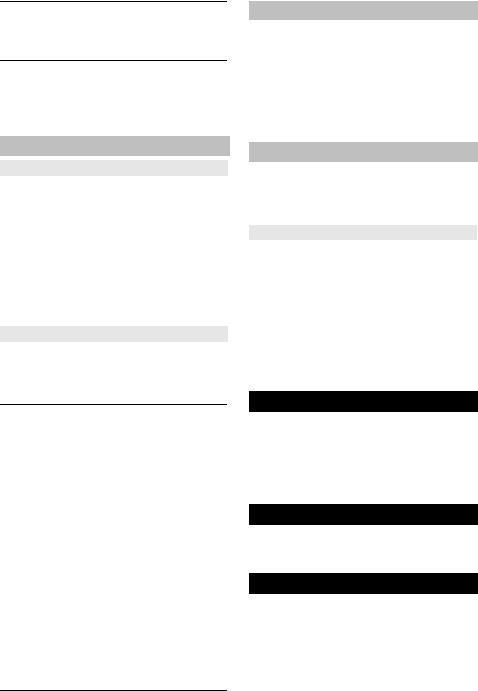
Appliance Set the appliance switch without(A) to "I".
and (B) The appliance switches on.
Unlock the trigger safety and pull the lever of the trigger gun.
Set working pressure and flow rate through turning (runless) at the pressureand amount regulation (B) (+/-).
Interrupting operation
Short break
Release the lever on the trigger gun. Appliance with pressure switch (B) switches off.
Appliances without pressure switch go into circuit operation.
Release the lever of the trigger gun again.
Appliance with pressure switch starts. Applianceswithout pressureswitchend circuit operation.
Longer break
Release the lever on the trigger gun.
Operate the trigger safety of the trigger gun to secure the lever of the gun against accidental triggering.
Appliance Place the trigger gun into with hold- the holder.
er for trig- The pump stops.
ger gun (A) Remove trigger gun from the holder.
The pump starts.
Appliance |
Set the appliance switch |
with pres- |
to "0/OFF“. |
sure |
The pump is switched off. |
switch (B) |
Set the appliance switch |
|
to "I". |
|
The pump is ready for op- |
|
eration. |
Appliance |
Set the appliance switch |
without(A) |
to "0/OFF“. |
and (B) |
The pump is switched off. |
Set the appliance switch to "I".
The pump starts.
Unlock the trigger safety and pull the lever of the trigger gun.
Turn off the appliance
Set the appliance switch to "0".
Disconnect the mains plug from the socket.
Shut off water supply.
Activate trigger gun until device is pres- sure-less.
Operate the trigger safety of the trigger gun to secure the lever of the gun against accidental triggering.
Frost protection
ATTENTION
Frost will destroy the not completely water drained device.
Store the appliance in a frost free area.
If you cannot store it in a frost-free place:
Drain water.
Pump in conventional frost protection agents through the appliance.
Note:
Use normal glycol-based anti-freezing agents for automobiles.
Observe handling instructions of the antifreeze agent manufacturer.
Operate device for max. 1 minute until the pump and conduits are empty.
Transport
When transporting in vehicles, secure the appliance according to the guidelines from slipping and tipping over.
CAUTION
Risk of personal injury or damage! Mind the weight of the appliance during transport.
Storage
CAUTION
Risk of personal injury or damage! Consider the weight of the appliance when storing it.
Care and maintenance
DANGER
Risk of injury by inadvertent startup of appliance and electrical shock.
Prior to all work on the appliance, switch off the appliance and pull the power plug.
Note:
Used oil must only be disposed of by the designated collection points. Please turn in
22 |
EN – 7 |

used oil there. Polluting the environment with used oil is prosecutable.
Safety inspection/ maintenance contract
You can sign with your dealer a contract for regular safety inspection or even sign a maintenance contract. Please take advice on this matter.
Before each use
Check connection cable for damages (risk of electrical shock); get the damaged connection cable replaced immediately by an authorised customer service person/ electrician.
Check the high pressure hose for damages (risk of bursting).
Please arrange for the immediate exchange of a damaged high-pressure hose.
Check appliance (pump) for leaks. 3 drops per minute are permitted and
can come out from the lower side of the appliance. Call Customer Service if there is heavy leakage.
Weekly
Check oil level Please contact Customer Service immediately if the oil is milky (water in oil).
Clean water filter.
Yearly or after 500 operating hours
Oil change.
Oil change
Note:
See "Specifications" for oil volume and type.
Unscrew oil drain plug.
Drain the oil in a collection basin.
Fix in the oil drain screw and tighten it. Torque 20...25 Nm.
Turn the oil fill screw out.
Fill in new oil slowly; air bubbles should go out.
The oil level must be at the centre of the oil level display.
Screw in oil filling screw.
Close cover.
Troubleshooting
DANGER
Risk of injury by inadvertent startup of appliance and electrical shock.
Prior to all work on the appliance, switch off the appliance and pull the power plug. Get the electrical components checked and repaired only by authorised customer service persons.
Contact an authorised customer service person in case of problems not mentioned in this chapter or if you are in doubt or when you have been explicitly asked to do so.
Appliance is not running
Only with appliances with holder for trigger gun: Do not push down the holder.
Check connection cable for damages.
Check the supply voltage.
Call Customer Service in case of electrical defects.
Pressure does not build up in the appliance
Set the pressure and quantity regulation to "MAX".
Check the nozzle size, install correct nozzle.
Clean the nozzle.
Replace the nozzle.
Deaerate the appliance (see "Start-up")
Check water supply level (refer to technical data).
Clean water filter.
Check all inlet pipes to the pump.
Contact Customer Service if needed.
Pump leaky
3 drops per minute are permitted and can come out from the lower side of the appliance. Call Customer Service if there is heavy leakage.
With stronger leak, have device checked by customer service.
Pump is vibrating
Clean water filter.
Check the water suction pipes for leaks.
Deaerate the appliance (see "Start-up")
Contact Customer Service if needed.
EN – 8 |
23 |

Water leak on the thermovalve |
Product: |
High pressure cleaner |
|||||||
|
Type: |
1.367-xxx |
|||||||
This function is not a fault. If the appliance |
|||||||||
|
|
|
|
|
|
|
|
||
becomes too hot in the circulation mode, |
Relevant EU Directives |
||||||||
the thermovalve opens so that cold water |
|||||||||
2006/42/EC (+2009/127/EC) |
|||||||||
can flow in. |
|||||||||
2014/30/EU |
|
|
|
||||||
Water leak at the safety valve |
2000/14/EC |
|
|
|
|||||
Turn off the appliance, wait briefly, turn |
2011/65/EU |
|
|
|
|||||
|
|
|
|
|
|
|
|
||
on the appliance once again. |
Applied harmonized standards |
||||||||
If the fault appears again afterwards, do |
EN 60335–1 |
|
|
|
|||||
no longer use the appliance. Have the |
EN 60335–2–79 |
||||||||
device checked by aftersales service. |
EN 55014–1: 2006+A1: 2009+A2: 2011 |
||||||||
|
EN 55014–2: 2015 |
||||||||
Spare parts |
|||||||||
EN 62233: 2008 |
|||||||||
– Only use accessories and spare parts |
EN 61000–3–2: 2014 |
||||||||
which have been approved by the man- |
EN 61000–3–11: 2000 |
||||||||
ufacturer. The exclusive use of original |
EN 50581 |
|
|
|
|||||
accessories and original spare parts |
Applied conformity evaluation method |
||||||||
ensures that the appliance can be oper- |
|||||||||
2000/14/EC: Appendix V |
|||||||||
ated safely and trouble free. |
|||||||||
|
|
|
|
|
|
|
|
||
– At the end of the operating instructions |
Sound power level dB(A) |
||||||||
youwillfindaselectedlistofspareparts |
|||||||||
HD 7/11-4 |
|
|
|
||||||
that are often required. |
Measured: |
87 |
|
||||||
– For additional information about spare |
Guaranteed: |
90 |
|
||||||
parts, please go to the Service section |
HD 7/16-4 |
|
|
|
|||||
at www.kaercher.com. |
Measured: |
87 |
|
||||||
|
Guaranteed: |
90 |
|
||||||
Warranty |
|||||||||
HD 9/18-4 |
|
|
|
||||||
The warranty terms published by the rele- |
Measured: |
84 |
|
||||||
vant sales company are applicable in each |
Guaranteed: |
87 |
|
||||||
country. We will repair potential failures of |
The undersigned act on behalf and under |
||||||||
your appliance within the warranty period |
|||||||||
free of charge, provided that such failure is |
the power of attorney of the company man- |
||||||||
caused by faulty material or defects in man- |
agement. |
|
|
|
|||||
ufacturing. In the event of a warranty claim |
|
|
|
|
|
|
|
|
|
|
|
|
|
|
|
|
|
||
please contact your dealer or the nearest |
|
|
|
|
|
|
|
|
|
authorized Customer Service centre. |
|
|
|
|
|
|
|
|
|
|
|
|
|
|
|
|
|
||
Please submit the proof of purchase. |
Chief Executive Officer |
|
Head of Approbation |
||||||
|
|
|
|
|
|
|
|
||
EU Declaration of Conformity
We hereby declare that the machine described below complies with the relevant basic safety and health requirements of the EU Directives, both in its basic design and construction as well as in the version put into circulation by us. This declaration shall cease to be valid if the machine is modified without our prior approval.
Authorised Documentation Representative
S. Reiser
Alfred Kärcher GmbH Co. KG
Alfred-Kärcher-Str. 28 - 40
71364 Winnenden (Germany)
Phone: +49 7195 14-0
Fax: +49 7195 14-2212
Winnenden, 2015-08-01
24 |
EN – 9 |

Technical specifications
Type |
|
HD 7/11-4 |
HD 7/16-4HD 9/18-4 |
HD 9/18-4 |
|
|||
Main Supply |
|
|
|
|
|
|
|
|
Voltage |
V |
220...240 |
380...415 |
|
380...480 |
|
||
Current type |
Hz |
1~50 |
3~50 |
|
3~60 |
|
||
Connected load |
kW |
2.9 |
4.3 |
|
5.9 |
|
6.9 |
|
Protection (slow, char. C) |
A |
13 |
|
|
16 |
|
|
|
Maximum allowed net impedance |
Ohm |
0.365 |
|
|
-- |
|
|
|
Type of protection |
-- |
|
IPX5 |
|
|
|
||
Extension cord 30 m |
mm2 |
|
2.5 |
|
|
|
||
Water connection |
|
|
|
|
|
|
|
|
Max. feed temperature |
°C |
|
60 |
|
|
|
||
Min. feed volume |
l/h (l/min) |
1000 (16,67) |
|
1200 (20) |
|
|||
Suck height from open container |
m |
|
0.5 |
|
|
|
||
(20 °C) |
|
|
|
|
|
|
|
|
Max. feed pressure |
MPa |
|
1.0 (10) |
|
|
|
||
|
(bar) |
|
|
|
|
|
|
|
Performance data |
|
|
|
|
|
|
|
|
Working pressure |
MPa |
7...11 |
7...16 |
|
7...18 (70...180) |
|
||
|
(bar) |
(70...110) |
(70...160) |
|
|
|
|
|
Max. operating over-pressure |
MPa |
15 (150) |
|
|
25 (250) |
|
|
|
|
(bar) |
|
|
|
|
|
|
|
Nozzle size |
-- |
050 |
040 |
|
050 |
|
055 |
|
Flow rate |
l/h (l/min) |
520...700 |
400...700 |
|
450...900 |
(7.5...15) |
|
|
|
|
(8.7...11.7) |
(6.7...11.7) |
|
|
|
|
|
Max. recoil force of trigger gun |
N |
29 |
35 |
|
48 |
|
53 |
|
Values determined as per EN 60335 |
-2-79 |
|
|
|
|
|
|
|
Hand-arm vibration value |
m/s2 |
|
<2.5 |
|
|
|
2.7 |
|
Uncertainty K |
m/s2 |
|
0.6 |
|
|
|
0.8 |
|
Sound pressure level LpA |
dB(A) |
74 |
87 |
|
84 |
|
78 |
|
Uncertainty KpA |
dB(A) |
|
3 |
|
|
|
|
|
Sound power level LWA + Uncertainty |
dB(A) |
90 |
90 |
|
87 |
|
93 |
|
KWA |
|
|
|
|
|
|
|
|
Fuel |
|
|
|
|
|
|
|
|
Amount of oil |
l |
|
0.4 |
|
|
|
||
Oil grade |
-- |
|
15W40 |
|
|
|
||
Dimensions and weights |
|
|
|
|
|
|
|
|
Length |
mm |
640 |
780 |
|
|
640 |
|
|
Width |
mm |
|
360 |
|
|
|
||
Height |
mm |
|
500 |
|
|
|
||
Weight, ready to operate with acces- |
kg |
50.5 |
56.5 |
|
55.2 |
|
61.2 |
|
sories |
|
|
|
|
|
|
|
|
|
EN – 10 |
|
|
|
25 |
|||
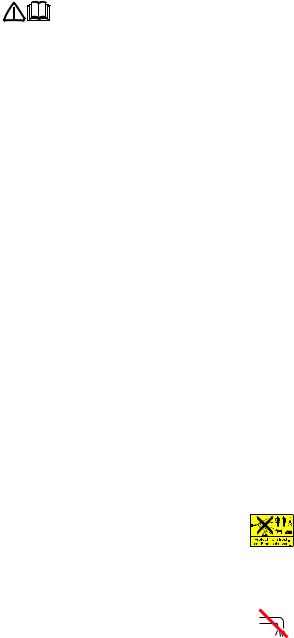
|
|
|
|
|
|
|
Lire ce manuel d'utilisation origi- |
|
|
|
|
|
||||
|
|
|
|
|
|
|
|
|
|
Consignes de sécurité |
||||||
|
|
|
|
|
|
|
nal avant la première utilisation |
|
|
|
||||||
|
|
|
|
|
|
|
|
– |
Avant la mise en route de l’appareil, lire |
|||||||
|
de votre appareil, le respecter et le conser- |
|
||||||||||||||
|
ver pour une utilisation ultérieure ou pour le |
|
|
les instructions de service et respecter |
||||||||||||
|
futur propriétaire. |
|
|
|
|
tout particulièrement les consignes de |
||||||||||
|
|
|
|
|
|
|
|
|
|
|
|
|
|
sécurité. |
||
|
|
|
|
|
Table des matières |
|
|
|
||||||||
|
|
|
|
|
|
|
– Afin d'assurer un fonctionnement sans |
|||||||||
|
Éléments de l'appareil. . . . . . . |
FR |
1 |
|
|
danger, observez les avertissements et |
||||||||||
|
Consignes de sécurité . . . . . . |
FR |
1 |
|
|
consignes placés sur l'appareil. |
||||||||||
|
Utilisation conforme . . . . . . . . |
FR |
4 |
|
– |
En plus des consignes figurant dans ce |
||||||||||
|
Dispositifs de sécurité. . . . . . . |
FR |
5 |
|
|
mode d'emploi, les règles générales de |
||||||||||
|
Protection de l’environnement |
FR |
5 |
|
|
sécurité et de prévention des accidents |
||||||||||
|
Avant la mise en service. . . . . |
FR |
6 |
|
|
imposées par la loi doivent être respec- |
||||||||||
|
Mise en service. . . . . . . . . . . . |
FR |
6 |
|
|
tées. |
||||||||||
|
Utilisation . . . . . . . . . . . . . . . . FR |
7 |
|
|
Symboles utilisés dans le mode |
|||||||||||
|
Transport. . . . . . . . . . . . . . . . . FR |
8 |
|
|
|
|
d'emploi |
|||||||||
|
Entreposage . . . . . . . . . . . . . . FR |
8 |
|
|
DANGER |
|||||||||||
|
Entretien et maintenance . . . . FR |
9 |
|
|||||||||||||
|
|
Signale la présence d'un danger imminent |
||||||||||||||
|
Service de dépannage . . . . . . FR |
9 |
|
|||||||||||||
|
|
entraînant de graves blessures corporelles |
||||||||||||||
|
Pièces de rechange . . . . . . . . FR |
10 |
|
|||||||||||||
|
|
et pouvant avoir une issue mortelle. |
||||||||||||||
|
Garantie . . . . . . . . . . . . . . . . . |
FR |
10 |
|
||||||||||||
|
|
|
AVERTISSEMENT |
|||||||||||||
|
Déclaration UE de conformité. FR |
11 |
|
|||||||||||||
|
|
Signale la présence d'une situation éven- |
||||||||||||||
|
Caractéristiques techniques . . FR |
12 |
|
|||||||||||||
|
|
tuellement dangereuse pouvant entraîner |
||||||||||||||
|
|
|
|
|
|
|
|
|
|
|
|
|
||||
|
|
|
Éléments de l'appareil |
|
|
de graves blessures corporelles et même |
||||||||||
|
Veuillez ouvrir la page d'image devant |
|
|
avoir une issue mortelle. |
||||||||||||
|
|
|
PRÉCAUTION |
|||||||||||||
|
Illustration |
|
|
|
|
|
||||||||||
|
|
|
|
|
||||||||||||
|
A Manche pour poignée pistolet * |
|
|
Remarque relative à une situation poten- |
||||||||||||
|
B |
Pressostat * |
|
|
|
tiellement dangereuse pouvant entraîner |
||||||||||
1 |
Interrupteur principal |
|
|
|
des blessures légères. |
|||||||||||
|
|
|
ATTENTION |
|||||||||||||
2 |
Arrivée d'eau |
|
|
|
||||||||||||
|
|
|
Remarque relative à une situation éven- |
|||||||||||||
|
3 Câble secteur avec fiche secteur |
|
|
|||||||||||||
|
|
|
tuellement dangereuse pouvant entraîner |
|||||||||||||
4 |
Calorstat * |
|
|
|
||||||||||||
|
|
|
des dommages matériels. |
|||||||||||||
|
5 Soupape de sécurité * |
|
|
|
||||||||||||
|
|
|
|
|
|
|
|
|||||||||
6 |
Raccord haute pression |
|
|
|
|
|
Symboles sur l'appareil |
|||||||||
|
7 Régulation de pression et de débit |
|
|
|
|
|
Des jets haute pression peuvent |
|||||||||
|
8 Bouchon de vidange d'huile |
|
|
|
|
|
|
|||||||||
|
|
|
|
|
|
|
être dangereux en cas d'utilisa- |
|||||||||
|
9 Indicateur de niveau d'huile |
|
|
|
|
|
|
|||||||||
|
|
|
|
|
|
|
tion non conforme. Le jet ne doit |
|||||||||
|
10 Vis de remplissage d'huile |
|
|
|
|
|
|
|||||||||
|
|
|
|
pas être dirigé sur des personnes, des ani- |
||||||||||||
|
11 Filtre à eau |
|
|
|
||||||||||||
|
|
|
|
maux, des installations électriques actives |
||||||||||||
|
12 Raccord vissé de buse |
|
|
|
||||||||||||
|
|
|
|
ni sur l'appareil lui-même. |
||||||||||||
|
13 Buse |
|
|
|
||||||||||||
|
|
|
|
|
|
|
Selon les directives en vigueur, |
|||||||||
|
14 Lance |
|
|
|
|
|
|
|||||||||
|
|
|
|
|
|
|
l'appareil ne doit jamais être ex- |
|||||||||
|
15 Poignée-pistolet |
|
|
|
|
|
|
|||||||||
|
16 Manette de la poignée-pistolet |
|
|
|
|
|
ploité sans séparateur de sys- |
|||||||||
|
17 Sécurité contre la mise en route |
|
|
|
|
|
tème sur le réseau d'eau potable. |
|||||||||
|
|
|
|
|
|
|||||||||||
|
18 Flexible haute pression |
|
|
|
Utiliser un séparateur système approprié |
|||||||||||
|
19 Enrouloir de câble / flexible |
|
|
|
de la société Kärcher ou en alternative un |
|||||||||||
|
* équipement en fonction de la versions |
|
|
séparateur système selon EN 12729 type |
||||||||||||
|
|
|
BA. |
|||||||||||||
|
d'appareil |
|
|
|
||||||||||||
|
|
|
|
|
|
|
|
|||||||||
26 |
|
|
|
|
|
|
|
|
|
|
FR – 1 |
|
|
|
||

L'eau qui s'est écoulée à travers un séparateur système est classifiée comme non potable.
L'appareil contient des surfaces très chaudes pouvant provoquer des brûlures.
Risque d'électrocution. Le boîtier ne doit être ouvert que par des électriciens spécialisés.
Raccordement électrique
–La tension indiquée sur la plaque signalétique de l'appareil doit correspondre à celle de la prise.
–Protection minimale par fusible de la prise de courant (voir les données techniques)
–Classe de protection I - Brancher les appareils uniquement aux sources d'électricité dûment mises à la terre.
–Il est recommandé de brancher cet appareil seulement à une prise de courant qui est assurée avec un commutateur de protection de courant d'erreur de 30 mA.
–Utiliser la ligne d'accès au réseau prescrite par le fabricant, cela est aussi valable en cas du remplacement de la ligne. N° de commande et type, voir le mode d'emploi.
–Vérifier avant chaque utilisation que le câble et la fiche mâle ne sont pas défectueux. Un câble d’alimentation endommagé doit immédiatement être remplacé par le service après-vente ou un électricien agréé.
–L’appareil doit uniquement être raccordé à un branchement électrique mis en service par un électricien conformément à la norme IEC 60364-1.
–Les procédures de mises en marche peut conduire à des baisses de tension de courte durée.
–Si le circuit électrique n'est pas approprié, d'autres appareils peuvent subir des endommagements.
–Ne jamais saisir le câble d’alimentation avec des mains mouillées.
–Veiller à ne pas abîmer ni endommager le câble d’alimentation ni le câble de rallonge en roulant dessus, en les coinçant ni en tirant violemment dessus. Protéger le câble d’alimentation contre la chaleur, l’huile et les arêtes tranchantes.
–Le câble de prolongation doit avoir la coupe transversale mentionnée dans le mode d'emploi et être protégé contre l'eau. La liaison ne doit jamais se trouver dans l’eau.
–La fiche secteur et le couplage d'une conduite de rallonge doivent être étanches et ne doivent pas reposer dans l'eau. Le raccord ne doit pas se situer sur le sol. Il est recommandé d'utiliser des enrouleurs de câble qui garantissent le fait que les prises se trouvent
àau moins 60 mm au-dessus du sol.
–Des rallonges électriques non adaptées peuvent présenter des risques. Utiliser
àl’air libre uniquement des câbles de rallonge électriques autorisés et marqués de façon adéquate avec une section suffisante du conducteur.
–Contrôler régulièrement que le câble d'alimentation secteur n'est pas endommagé, par exemple par formation de fissures ou du fait du vieillissement. S'il est endommagé, remplacer le câble avant toute nouvelle utilisation.
–En cas de remplacement des raccords du câble d'alimentation ou de la rallonge, s'assurer que la protection antiéclaboussures et la résistance mécanique ne sont pas compromises.
–L’appareil ne peut être nettoyé à l'eau avec un flexible ou au jet haute pression (Danger de court-circuits ou autres dégâts).
–Ne pas exploiter l'appareil à des températures inférieures à 0 °C
Arrivée d'eau
–Observez les instructions de votre entreprise d'approvisionnement en eau.
–Le boulonnage de tous les tuyaux de raccord doit être étanche.
FR – 2 |
27 |

–Il est impératif que le flexible haute pression ne soit pas endommagé. Tout flexible haute pression défectueux doit être remplacé immédiatement. Seuls les flexibles et les branchements recommandés par le fabricant doivent être utilisés. N° de commande, voir le mode d'emploi.
Application
–Il est nécessaire de contrôler l'état et la sécurité du fonctionnement de l'appareil et de ses équipements avant toute utilisation.
Ne pas utiliser l'appareil lorsqu'une conduite de raccordement ou des pièces importantes de l'appareil sont endommagées, par ex. les dispositifs de sécurité, les flexibles haute pression, les poignées-pistolets.
–Ne jamais aspirer des liquides contenant des solvants ni des acides ou des solvants non dilués, tels que par exemple de l’essence, du diluant pour peinture ou du fuel ! Le nuage de pulvérisation est extrêmement inflammable, explosif et toxique. Ne pas utiliser d’acétone, d’acides ni de solvants non dilués, du fait de leur effet corrosif sur les matériaux constituant l’appareil.
–Si l’appareil est utilisé dans des zones de danger (par exemple des stations essence), il faut tenir compte des consignes de sécurité correspondantes. Il est interdit d’exploiter l’appareil dans des pièces présentant des risques d’explosion.
–L'appareil doit reposer sur un sol stable et plan.
–Si le niveau des pression acoustique indiqué dans ces instructions de service (Données techniques) est supérieur à 80 dB(A), il faut porter un protecteur d’oreille.
–Toutes les pièces conductrices dans la zone de travail doivent être protégées contre les jets d’eau.
–Lors du fonctionnement, ne pas coincer la manette de la poignée-pistolet.
–Pour se protéger contre les éclaboussures ou les poussières, porter le cas échéant des vêtements et des lunettes de protection.
–Une utilisation incorrecte des jets haute pression peut présenter des dangers. Le jet ne doit pas être dirigé sur des personnes, des animaux, des installations électriques actives ni sur l'appareil luimême.
–Ne jamais diriger le jet sur soi-même ni sur d’autres personnes dans le but de nettoyer les vêtements ou les chaussures.
–Les pneus/clapets de pneus peuvent être nettoyés avec une distance minimale de 30 cm. Sinon, les pneus/clapets de pneus peuvent être endommagés par le jet à haute pression. Le premier signe d'un dommage est le changement de couleur du pneu. Des pneus endommagés sont une source de danger.
–Des matériaux qui contient de l'amiante et autres matériaux qui contiennent des substances dangereux pour la santé ne peuvent être aspergés.
–Dans le cas des lances courtes, il existe un risque de blessure car une main peut être par inadvertance en contact avec le jet haute pression. Si la lance utilisée est d'une longueur inférieure à 75 cm, aucune buse à jet crayon ou aucune rotabuse ne doit être utilisée.
–Avant le nettoyage, une évaluation des risques de la surface à nettoyer doit être effectuée pour déterminer les exigences relatives à la sécurité et à la protection de la santé. En conséquence, les mesures de protection nécessaires doivent être prises.
–Laisser refroidir les flexibles après le mode eau chaude et exploiter l'appareil brièvement avec le mode eau froide.
–Lors des pauses d'exploitation prolongées, mettre l'appareil hors service au niveau du sectionneur général / de l'interrupteur d'appareil ou de la fiche secteur.
28 |
FR – 3 |
|
|
vice et en cas des appareil d'exploita- |
|||||
Utilisation |
|||||||
|
|
tion des réseaux débrancher la prise. |
|||||
– L’utilisateur doit utiliser l’appareil de fa- |
|||||||
|
– Retirer la pression du système haute |
||||||
çon conforme. Il doit prendre en consi- |
|
pression avant tous travaux sur l'appa- |
|||||
dération les données locales et lors du |
|
||||||
|
reil et les accessoires. |
|
|
|
|
||
maniement de l’appareil, il doit prendre |
|
|
|
|
|
||
|
– Les maintenances doivent être unique- |
||||||
garde aux tierces personnes, et en par- |
|
ment effectuées par des services d'as- |
|||||
ticulier aux enfants. |
|
||||||
|
sistances au client autorisés ou par des |
||||||
– Pendant le fonctionnement de l'appa- |
|
||||||
|
spécialistes. |
|
|
|
|
||
reil, il doit être tous le temps surveillé. |
|
|
|
|
|
||
|
– Les appareils utilisés industriellement |
||||||
– L'appareil doit uniquement être utilisée |
|
dans des locaux différents doivent être |
|||||
par des spécialistes qui sont instruits |
|
||||||
|
soumis à une révision de sécurité selon |
||||||
dans la manoeuvre ou par des per- |
|
||||||
|
les directives locales en vigueur (en Al- |
||||||
sonnes qui peuvent justifiée leur apti- |
|
||||||
|
lemagne, VDE 0701, par exemple). |
||||||
tude d'utilisation et qui sont explicite- |
|
||||||
|
|
|
|
|
|
||
|
Accessoires et pièces de rechange |
|
|||||
ment mandatées pour l'utilisation. Ne |
|
|
|||||
jamais laisser des enfants ou des ado- |
|
– Afin d'éviter tout danger, seul le service |
|||||
lescents utiliser l'appareil. |
|
après-vente agréé est habilité à effectuer |
|||||
– Cet appareil n'est pas destiné à être uti- |
|
des réparations ou à monter des pièces |
|||||
lisé par des personnes avec des capa- |
|
de rechanger sur l'appareil. |
|||||
cités physiques, sensorielles ou men- |
|
– Utiliser uniquement des accessoires et |
|||||
tales restreintes. |
|
des pièces de rechange autorisés par le |
|||||
– L’appareil ne doit jamais être utilisé par |
|
fabricant. Des accessoires et des pièces |
|||||
des enfants ni par des personnes non |
|
de rechange d’origine garantissent un |
|||||
avisées. |
|
fonctionnement sûr et parfait de l’appareil. |
|||||
– L’appareil ne doit jamais être utilisé si |
|
|
|
|
|
|
|
|
Utilisation conforme |
|
|
||||
d’autres personnes figurent dans le |
|
|
|||||
|
Utiliser exclusivement ce nettoyeur haute |
||||||
rayon de portée de l’appareil, à moins |
|
||||||
que ces personnes ne portent des vête- |
|
pression |
|
|
|
|
|
ments de protection. |
|
– pour le nettoyage au jet haute pression |
|||||
– Les enfants doivent être surveillés pour |
|
sans détergent (par ex. nettoyage de fa- |
|||||
s'assurer qu'ils ne jouent pas avec l'ap- |
|
çades, de terrasses, d'appareils de jardi- |
|||||
pareil. |
|
nage, de véhicules ou d'objets similaires) |
|||||
– Effectuer les travaux à l'appareil tou- |
|
Pour des salissures tenaces nos recom- |
|||||
jours avec des gants appropriées. |
|
mandons le fraiseur de saleté comme ac- |
|||||
– Le jet d'eau qui sort de la lance pro- |
|
cessoire en option. |
|
|
|
|
|
voque une réaction à la lance. La lance |
|
Exigences à la qualité d'eau : |
|||||
pliée provoque une force vers le haut. |
|
ATTENTION |
|
|
|
|
|
Bien tenir le pistolet et le tube d'acier. |
|
Utiliser uniquement de l'eau propre comme |
|||||
– En cas d'utilisation de dispositifs d'arro- |
|
||||||
|
fluide haute pression. Des saletés en- |
||||||
sage pliés, il est possible que la réac- |
|
||||||
|
traînent une usure prématurée ou des dé- |
||||||
tion à la lance et la force de rotation |
|
||||||
|
pôts dans l'appareil. |
|
|
|
|
||
soient modifiées. |
|
|
|
|
|
||
|
Si de l'eau de recyclage est utilisée, les va- |
||||||
|
|
||||||
Transport |
|||||||
|
leurs limites suivantes ne doivent pas être |
||||||
Au transport, le moteur de l'appareil doit |
|
dépassées. |
|
|
|
|
|
être arrêté et l'appareil doit être bien fixé. |
|
Valeur de pH |
6,5...9,5 |
|
|
|
|
Maintenance |
|
conductivité électrique * |
Conductivité |
|
|
|
|
– Avant le nettoyage et la maintenance |
|
|
de l'eau du ro- |
|
|||
de l'appareil et le changement des |
|
|
binet +1200 |
|
|||
pièces, l'appareil doit être mis hors ser- |
|
|
µS/cm |
|
|||
FR – 4 |
29 |
||||||
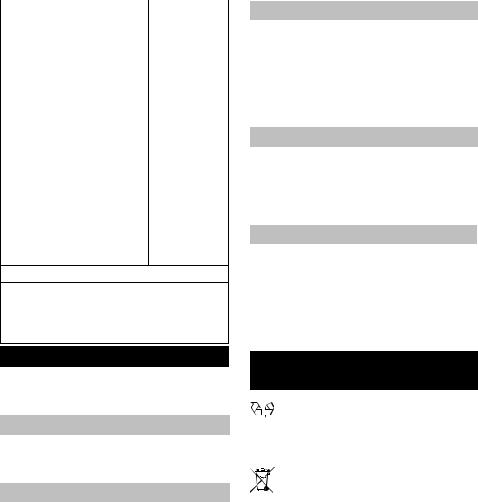
substances qui se dé- |
< 0,5 mg/l |
posent ** |
|
substances qui peuvent |
< 50 mg/l |
être filtrées *** |
|
Hydrocarbures |
< 20 mg/l |
Chlorure |
< 300 mg/l |
Sulfate |
< 240 mg/l |
calcium |
< 200 mg/l |
Dureté globale |
< 28 °dH |
|
< 50 °TH |
|
< 500 ppm |
|
(mg CaCO3/l) |
Fer |
< 0,5 mg/l |
Manganèse |
< 0,05 mg/l |
Cuivre |
< 2 mg/l |
Chlore actif |
< 0,3 mg/l |
exempt de mauvaises odeurs
* Total maximal 2000 µS/cm
** Volume d'essai 1 l, temps de dépose 30 min
*** pas de substance abrasive
Dispositifs de sécurité
Les dispositifs de sécurité ont pour but de protéger l'utilisateur et ils ne doivent donc jamais être désactivés ni évités.
Sécurité contre la mise en route
La sécurité contre la mise en route au niveau de la poignée pistolet empêche une mise en marche involontaire de l'appareil.
Clapet de décharge
–Encasderéductiondelaquantitéd'eau avec le réglage de pression/quantité, la clapet de décharge s'ouvre et une partie de l'eau est évacuée vers le côté aspiration de la pompe.
–Si la poignée-pistolet est fermée, la
vanne de décharge s'ouvre et la quantitéd'eautotalerevientaucôtéaspiration de la pompe.
Le clapet de décharge est réglé et plombé d'usine. Seul le service après-vente est autorisé à effectuer le réglage.
Soupape de sûreté
Le clapet de sécurité s'ouvre, lorsque le clapet de décharge est en panne.
La soupape de sûreté est réglée et plom- béed'usine.Seulleserviceaprès-venteest autorisé à effectuer le réglage.
Toutes les versions d'appareil ne sont pas équipées d’une soupape de sécurité.
Clapet thermique
Le clapet thermique protège la pompe haute pression contre un réchauffement non autorisé en mode de circuit.
Toutes les versions d'appareil ne sont pas équipées d’un calorstat.
Pressostat
Si vous relâchez la gâchette, la pompe est éteinte par un manu contacteur, le jet haute pression est interrompu. Si vous appuyez à nouveau sur le levier, la pompe est remise en marche.
Toutes les versions d'appareil ne sont pas équipées d’un pressostat.
Protection de l’environnement
 Les matériaux constitutifs de l’embal-
Les matériaux constitutifs de l’embal-
lage sont recyclables. Ne pas jeter les emballages dans les ordures ménagères, mais les remettre à un système de recyclage.
Les appareils usés contiennent des matériaux précieux recyclables les-  quels doivent être apportés à un système de recyclage. Les batteries et les accumulateurs contiennent des substances ne devant pas être tout simplement jetées. Pour cette raison, utiliser des systèmes de collecte adéquats afin d'éliminer les batte-
quels doivent être apportés à un système de recyclage. Les batteries et les accumulateurs contiennent des substances ne devant pas être tout simplement jetées. Pour cette raison, utiliser des systèmes de collecte adéquats afin d'éliminer les batte-
ries et les accumylatuers.
Instructions relatives aux ingrédients (REACH)
Les informations actuelles relatives aux ingrédients se trouvent sous : www.kaercher.com/REACH
30 |
FR – 5 |
